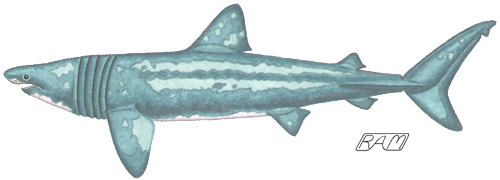Sea Monsters: Two Cases of
Mistaken Identity

Basking Sharks (Cetorhinus maximus) sometimes cause a fuss by being mistaken for something else. Dead Baskers often wash ashore, perhaps owing to the buoyancy afforded by the large, oily liver combined with the gases liberated by decomposition of the gastrointestinal tract. This tendency renders Basking Sharks particularly notorious among cryptozoologists, as their rotting carcasses have frequently been reported as 'sea serpents'.
Such reports are due largely to the Basking Shark's characteristic pattern of decay: after the skeletal elements supporting the gills slough off, what remains is a tiny skull on the end of a long, plesiosaur-like 'neck' (remnants of the gills may further disguise the piscine origin of the carcass by giving the impression of a 'mane'); a deep 'chest' with large pectoral flippers; adding to the carcass' overall strangeness, the claspers of a male Basker may appear like a sixth pair of flippers or legs; and — because the backbone extends into the upper lobe of the caudal fin — the lower lobe may rot away, leaving a single-lobed, snake-like tail.
The end result of all this post mortem transformation is a carcass that looks remarkably like the popular conception of a sea monster. In fact, one of these washed-up Baskers — the so-called Stronsa Beast of 1808 — was thought to be a whole new kind of creature and even given a formal scientific name, Halsydurus maximus ("great sea snake") before the blunder was discovered. As recently as April 1977, it nearly happened again when a plesiosaur-like creature was hauled up in the nets of a Japanese commercial fishing vessel off New Zealand. Dubbed the New Zealand Monster, examination of its cartilaginous skull and vertebrae quickly established its identity as our old friend, the Basking Shark.
Basking Sharks resemble and are closely related to the mackerel sharks (family Lamnidae). Baskers are superficially most similar to, but far more commonly seen at the surface than, the infamous White Shark (Carcharodon carcharias). To those who have seen both species in the wild, they are easy to distinguish by behavior alone: a White Shark generally swims in a more 'purposeful' manner and is much more likely to alter its course to investigate a boat than a disinterested, gently grazing Basker. Most people, of course, have never seen a White Shark in its natural habitat, but most have at least heard of this near-legendary predator.
Given their quite similar appearance when seen from above (as from the vantage of a boat deck), it is hardly surprising that free-swimming Basking Sharks are often reported as White Sharks During the summer of 1978, for example, there appeared off Long Island what looked for all the world like a giant White Shark, more than 30 feet (9 metres) long. The huge shark was quickly dubbed the 'Montauk Monster' by local media. Aerial photographs published in local newspapers clearly revealed that it was actually a medium-sized Basker. Like so many other before them, the newspaper journalists responsible for the sensational story had been influenced by their desires, transforming a harmless Basking Shark into a gigantic man-eating 'monster'.
